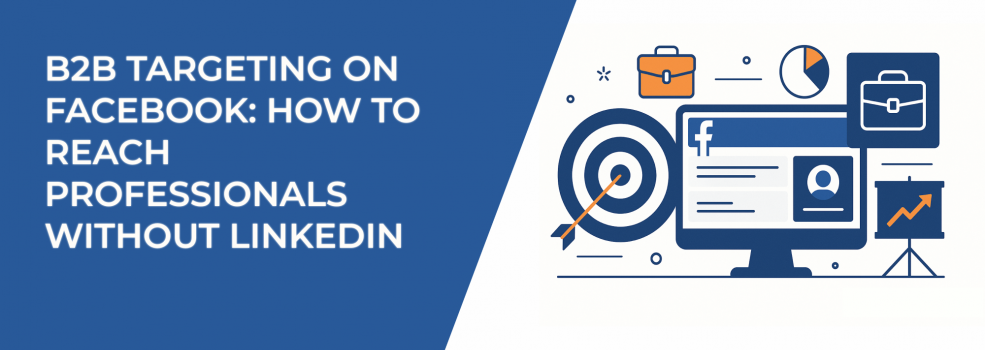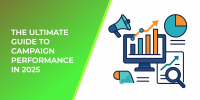LinkedIn may feel like the natural home for B2B advertising, but putting all your eggs in one basket limits your reach. Facebook has over 3 billion users worldwide, and a huge share of them are professionals. From entrepreneurs and managers to specialists in IT, logistics, and real estate — they’re on Facebook daily.
The question is: how do you cut through the noise and reach these people without wasting ad spend on irrelevant clicks?
This guide breaks down practical strategies for B2B targeting on Facebook. You’ll learn how to build better audiences, create ads professionals actually want to see, and keep your brand in front of decision-makers throughout the sales cycle.
Why Use Facebook for B2B Marketing?
Many B2B marketers hesitate to invest in Facebook ads because they assume it’s only for consumer brands. That’s a mistake.
Here’s why Facebook works for B2B:
-
Massive reach: While LinkedIn has about 1 billion users, Facebook has more than triple that number. Even niche industries have thousands of active groups and communities on Facebook.
-
Lower costs: LinkedIn ads are notoriously expensive, with average CPCs often two to three times higher than Facebook’s. With the right setup, you can generate quality leads at a fraction of the price.
-
Variety of placements: Ads don’t just show up in feeds. You can appear in Stories, Messenger, in-stream videos, and even within groups where professionals spend their downtime.
-
Daily engagement: Surveys show that over 70% of professionals check Facebook at least once per day — more often than LinkedIn.
Think of it this way: on LinkedIn, people are in “work mode.” On Facebook, they’re more relaxed. Catching them in that state often makes your ads feel less like a pitch and more like useful information.
Step 1: Build the Right Audience
The quality of your targeting determines the quality of your leads. Don’t just choose “Business owners” and hope for the best. Instead, layer filters to zero in on real decision-makers.
Practical ways to build B2B audiences:
-
Job-related interests: Look for interests like “business software,” “supply chain management,” “startup funding,” or “digital transformation.” These indicate professional focus.
-
Education and employers: Narrow by higher education, certain industries, or recognizable employers in your niche. For example, target “Marketing Managers” who studied Business Administration.
-
Custom audiences: Upload CRM exports or email lists to retarget current or past leads. This keeps you top-of-mind without chasing cold traffic.
-
Lookalike audiences: Create lookalikes based on your best existing B2B clients. Facebook will automatically find similar users with matching behaviors.
-
Layered targeting: Combine multiple signals. Example: small business owners + engaged with SaaS pages + recent activity in entrepreneurship groups.
Pro tip: Start with a broader audience, then gradually add layers to see where results improve. Over-targeting too early often reduces reach and drives up costs.
To sharpen your targeting even further, our article Facebook Ad Targeting 101: How to Reach the Right Audience breaks down the fundamentals every advertiser should master.
Step 2: Share Content That Professionals Value
Your ad creative is what makes someone stop scrolling. For B2B audiences, relevance and usefulness win every time.
Content that works well for B2B Facebook ads:
-
Case studies: Share real examples (anonymized if needed) of how businesses saved money or boosted efficiency with your product.
-
Free resources: Whitepapers, calculators, checklists, or templates that help professionals solve common problems.
-
Quick expert insights: Short videos or carousel posts with industry tips. This positions your brand as a thought leader.
-
Testimonials with depth: Go beyond “great product.” Instead, use testimonials that reference solving specific business challenges, like “reduced onboarding time by 30%.”
Ask yourself: If I were a manager scrolling after work, would I stop for this ad? If the answer is no, make it sharper.
Pro tip: B2B doesn’t have to mean boring. Use visuals, metaphors, and even light humor if it fits your audience.
Once you know what type of content to share, the next step is nailing your messaging — see our tips in Crafting Compelling Facebook Ads Copy That Converts.
Step 3: Retarget for Long Sales Cycles
B2B sales rarely close on first contact. The buying process often involves research, internal approvals, and multiple stakeholders. That’s why retargeting on Facebook is critical.
Retargeting ideas for B2B campaigns:
-
Content engagers: Target people who watched 50%+ of your video or read a blog post but didn’t take action.
-
Website visitors: Segment by page type — pricing page visitors may be closer to purchase than blog readers.
-
Lead magnet downloaders: Show follow-up ads to users who downloaded your report but didn’t book a demo.
-
Past leads: Upload CRM data and retarget warm leads with new offers or reminders.
Pro tip: Create different ad creatives for each retargeting stage. Early-stage leads should see educational content, while pricing-page visitors should see testimonials or limited-time offers.
If you haven’t set up structured retargeting campaigns yet, our walkthrough on How to Set Up Facebook Retargeting covers everything you need.
Step 4: Use LeadEnforce for Laser-Focused Targeting
Facebook’s native targeting options are powerful, but they don’t always give the precision B2B marketers need. This is where LeadEnforce makes a real difference.
With LeadEnforce, you can create audiences of people who follow specific Facebook groups and pages. For B2B advertisers, that’s a goldmine.
Professionals often cluster in niche communities:
-
Real estate agents in local realtor groups.
-
HR managers in recruitment and workplace culture communities.
-
Small business owners following industry associations or chambers of commerce.
-
IT professionals engaging with SaaS and cybersecurity pages.
By targeting these groups directly, you reach people who already identify with your industry — no guesswork required. LinkedIn has company pages, but it can’t replicate this type of Facebook community targeting at scale.
Pro tip: Test audiences from several groups and compare performance. Some communities may engage more actively than others.
If you’d like a detailed walkthrough of this approach, check out How to Build Your Target Audience from a Facebook Group — it explains how to turn active communities into high-quality ad audiences.
Step 5: Test, Measure, and Scale
Even the best targeting won’t work without proper testing.
Rules for scaling B2B campaigns on Facebook:
-
Start small — Begin with small budgets to test creatives and audiences. Double down only on what works.
-
Measure the right metrics — Don’t obsess over CTR alone. Focus on cost per qualified lead and eventual ROI.
-
Refresh creatives — Professionals burn out on ads quickly. Plan to rotate new visuals or offers every 3–4 weeks.
-
Try different placements — Don’t just stick to feeds. Ads in Messenger, Stories, or in-stream video can deliver strong results at lower costs.
-
Control frequency — Too few impressions mean people don’t notice you. Too many lead to annoyance. A good rule of thumb is 3–7 impressions per user over 7 days.
Pro tip: Use Facebook’s breakdown reports (age, placement, device) to find hidden insights. You may discover that certain industries respond better on mobile, while others prefer desktop.
Final Thoughts
B2B targeting on Facebook is all about precision and patience. Instead of treating it like a consumer platform, think about how to provide value to professionals, build trust, and stay present during long decision cycles.
By layering audiences, creating useful content, running smart retargeting campaigns, and using advanced tools like LeadEnforce, you can reach professionals in ways LinkedIn simply can’t match — and often at a much lower cost.
Facebook isn’t just for consumer ads anymore. For B2B marketers who are willing to get strategic, it’s a channel full of untapped opportunities.

